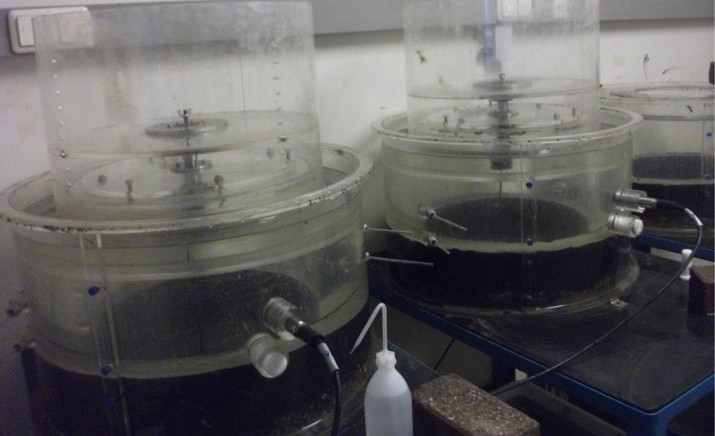Flumes & Wave Mesocosms
SITE UNDER CONSTRUCTION...
Estuarine and marine ecosystems are highly valuable ecosystems that provide many ecosystem services to society. These coastal and marine ecosystems are strongly influenced by hydrodynamic forces originating from tidal currents and waves. NIOZ-Yerseke has a long tradition in studying these bio-physical interactions.
These studies include:
i) how the forces originating from tidal currents and waves affect species performance, community structure and community interactions
ii) how marine and estuarine organisms alter the physical environment by changing hydrodynamic forces, thereby affecting sediment transport and pore-water fluxes
To study these biophysical interactions we use flume systems and wave mesocosms. A flume is like a wind tunnel that serves to control water movement by a combination of flow and waves. Ultimately, we aim to understand how the bio-physical interaction between the above mentioned items i & ii affects spatial development, functioning and resilience of the estuarine and coastal ecological landscape.
Furthermore, we want to know how the biophysical interactions affects the sensitivity of these coastal systems to global-scale processes like, for instance, sea level rise and climate change, and to local-scale anthropogenic disturbances such as dredging and eutrophication.
With a fundamental understanding of the ecosystem functioning in a biophysical context, we can provide the knowledge base for sustainable use of these valuable ecosystems, e.g. for nature-based flood defence.
-
What makes the NIOZ facilities unique?
Many flume systems are used at various institutes around the world. These allow studying hydrodynamic processes under different flow regimes and/or wave climates. Many of the flumes are designed for engineering studies, and are almost perfect in mimicking the physical processes.
Yet, the flumes and wave mesocosms at NIOZ are designed with another purpose: to study living organisms in their natural water environment (salt, brackish or fresh), including the presence of sediment (sand or mud). Although the hydrodynamic forcing may in some cases be less perfect compared to that in technical flumes, we have the ability and experience to keep organisms alive for a prolonged time. The latter allows us to do both physical and behavioral studies with living organisms. But of course, studies with mimics are also possible.
We have developed different types of systems for different types of questions:
i) Some of the questions require organisms or communities to be exposed for a long-time to a given set of hydrodynamic conditions. This is to allow them to adjust their development to the hydrodynamic forcing. For these kinds of questions we have developed systems with relatively simple hydrodynamic controls, so that we can have replicates (e.g., mini-flumes, annular flumes and wave-mesocosms).
ii) Other questions require short periods of high quality hydrodynamic measurements around living organisms. For these kinds of questions we have developed / are developing a range of flume systems, such as laboratory flumes with more advanced hydrodynamic conditions (e.g., the racetrack flume), and field flumes with more limited hydrodynamic control (e.g., OsCar & MoBi-WAVE).
To our knowledge, world-wide only a limited number of biological-oriented flumes are available; field flumes are even more rare. Currently, NIOZ is seriously investing in the development of field flumes for ecological research.
-
Whom to contact for using NIOZ flumes facilities or wave mesocosms?
To maximize scientific progress, NIOZ has a long tradition of sharing their facilities with the scientific community. However, translating a cool scientific idea into a well-suited flume experiment requires in-depth knowledge and experience of how the various systems work. There is no such thing as a 'perfect flume'; there is only the most suitable flume for answering a specific question. For this reason, we like to have all requests for using these NIOZ facilities to be directed to the scientist in charge: Tjeerd Bouma (email: tjeerd.bouma@nioz.nl). Based on research goals and technical possibilities, the experimental plan will be tailored to get the best possible science resulting in the best joined publications.
As NIOZ, we are proud to be flexible in even thinking about "duct-tape solutions" to make things possible. The work on mangrove propagule dispersal, in which a simple wind tunnel was constructed on top of a flume, may serve as an examples for this flexibility. The wind speed was made adjustable by drillling a number of holes in the air supply, while using rubber stoppers to open and close these holes.
Racetrack Flume
Lab flume enabling flows & waves.

Dimensions: 17 m long (2 m test section) x 0.6m wide x 0.4m water.
Hydrodynamics: current velocities (0-80 cm/s) & small regular waves.
Options: add wind-tunnel over the flume.
Publications: see below
Contact: tjeerd.bouma@nioz.nl
Mini Flumes
12 lab flumes: 3 velocities with 4 replicates per velocity)


Dimensions: 13 x 26 x 130 cm (hold 5 stainless pots of 12 x 12 x 25 cm)
Hydrodynamics: 4 x 0.01 m/s & 4 x 0.10 m/s & 4 x 0.35 m/s
Options: to add pH control or temperature control
Publications: see below.
Contact: tjeerd.bouma@nioz.nl
Annular Flumes
8 replicate flumes.

Dimensions: 31.4 liter; .. cm OD ; .. cm ID; .. cm height
Hydrodynamics: up to 50 cm/s
Options: measure turbidity to detect critical erosion thresholds
Publications: see below
Contact: tjeerd.bouma@nioz.nl
Wave Mesocosms
4 replicates

Dimensions: 270 cm long x 90 cm wide x 90 cm deep
Hydrodynamics: irregular waves
Options:
Publications:
Zooming in and out: Scale dependence of extrinsic and intrinsic factors affecting salt marsh erosion
Heng Wang, Daphne van der Wal, Xiangyu Li, Jim van Belzen, Peter M. J. Herman, Zhan Hu, Zhenming Ge, Liquan Zhang, Tjeerd J. Bouma
Contact: tjeerd.bouma@nioz.nl